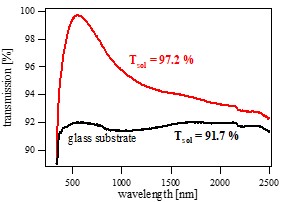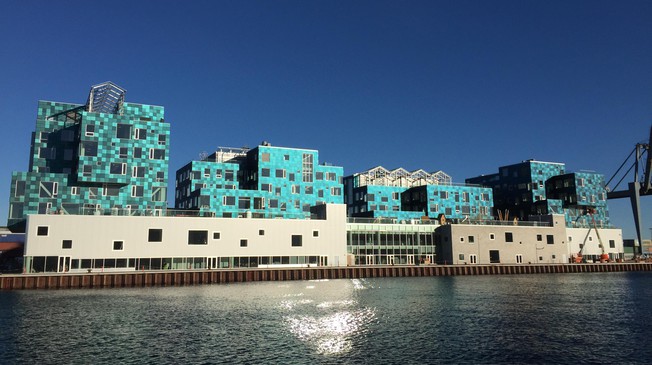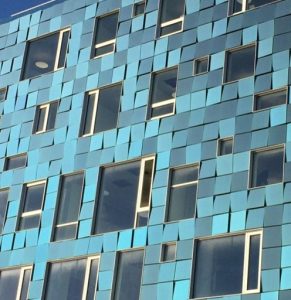Structured optical coatings on solar glass for photovoltaic modules and solar thermal collectors
Contact: Dr Andreas Schueler
Nanoporous silicon dioxide films exhibit a low refractive index suitable for broad band anti-reflection, and such coatings enter the market now. Nanocomposite quaternary Mg‑F‑Si‑O films exhibit also a low refractive index in the desired range, and might be more resistant regarding gradual pore-filling by hydrocarbons. Applying materials with a lower refractive index than silicon dioxide (refractive index approx. 1.46) allows for a larger spectral region of anti-reflection as compared to coatings based on materials with the refractive index equal or higher than that of silicon dioxide [HPD2013](see Fig.1).
Nanocomposite Ti‑Si‑O films are used in novel multilayered coatings on solar glazing. Such coatings combine a colored reflection with a high solar transmittance and open new possibilities for the architectural integration of solar collectors in building facades. The optical performance of the multilayered interference filters is optimized by computer simulations of thin film interference. These interference filters manufactured by the sol-gel dip-coating process or magnetron sputtering techniques. Optical measurements, such as spectrophotometry or ellipsometry, are used to determine film thicknesses and optical constants of individual layers, and to measure color coordinates and solar transmission for the multilayer stacks. Nanostructured materials are tailored for maximizing the optical performance.
Based on this technology, our group has developed novel colored solar glazing for thermal collectors and photovoltaic collectors for architectural integration into buildings [MER2014]. A convincing architectural integration of photovoltaic modules based on our technology has been achieved with the project of the Copenhagen International School – to our knowledge the building with the world’s largest photovoltaic façade today [JOL0217](see Fig. 2). The novel colored photovoltaic modules are also suitable for roof-integration in residential buildings.
Publications
[HOD2013] Hody-Le Caër, V., de Chambrier, E., Mertin, S., Joly, M., Schaer, M., Scartezzini, J.-L., Schüler, A., Optical and morphological characterisation of low refractive index materials for coatings on solar collector glazing, Renewable Energy 53, 27-34 (2013)
https://doi.org/10.1016/j.renene.2012.10.052
[JOL2017] Jolissaint, N., Hanbali, R., Hadorn, J.-C., Schüler, A., Colored solar façades for buildings, (2017) Energy Procedia, 122, pp. 175-180. Describes our novel PV technology integrated to building façades. https://doi.org/10.1016/j.egypro.2017.07.340
[MER2014] Mertin, S., Hody-Le Caër, V., Joly, M., Mack, I., Oelhafen, P., Scartezzini, J.-L., Schüler, A., Reactively sputtered coatings on architectural glazing for coloured active solar thermal façades, (2014) Energy and Buildings, 68 (PART C), pp. 764-770
https://doi.org/10.1016/j.enbuild.2012.12.030
Internet link EPFL News:
https://actu.epfl.ch/news/the-school-with-the-largest-solar-facade-in-the-wo/

Fig.1: Broad band antireflection of solar collector glazing by novel quaternary Mg-F-Si-O coatings developed at LESO-PB. The solar transmittance can be raised from 91.7% for the uncoated white solar glass to 97.2% for the coated glass. In order to achieve antireflection in the full solar range (UV-VIS-NIR), a low refractive index around 1.22 is necessary. This has been achieved previously only by nanoporous SiO2 films, and such coatings are entering the market now. The novel Mg-F-Si-O films might be more resistant towards gradual pore filling by hydrocarbons. [HOD2013]


Fig. 2: The Copenhagen International School featuring today’s world’s largest façade. The KROMATIX technology was developed in A. Schüler’s research group at EPFL/LESO-PB. [JOL2017]
Top) 13’000 photovoltaic modules cover a surface area of 6’600 m2. The installed peak power is 720 kWp. The building is located next to the harbor.
Bottom) The photovoltaic modules are of seagreen color, and the tilt angle varies slightly from module to module. Both features are reminiscent of the neighboring water, and highlight the relation of the building with its environmental context.